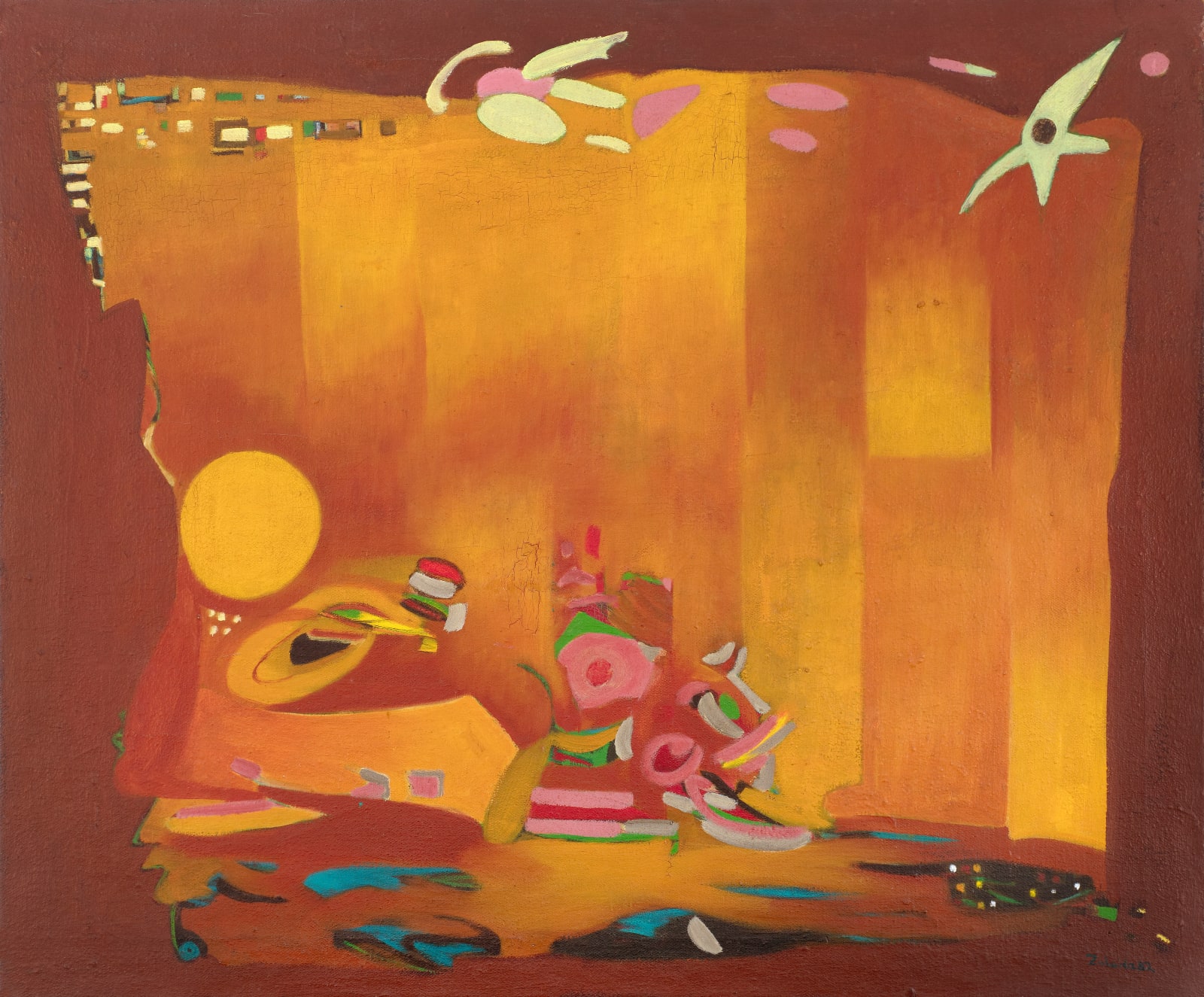Zubeida Agha
Interior, 1982
Oil on canvas
76.3 x 91.5 cm
30 x 36 in
30 x 36 in
Signed and dated 'Zubeida 82' lower right and further inscribed ‘Interior / Rs 8000’ on reverse of stretcher
[Zubeida Agha] had visions of bright colors and shapes full of deep intent long before she ever contemplated painting.' (The Art Critic, 'Paintings that portray ideas to be exhibited', Dawn,...
[Zubeida Agha] had visions of bright colors and shapes full of deep intent long before she ever contemplated painting.'
(The Art Critic, 'Paintings that portray ideas to be exhibited', Dawn, 25 May 1949)
Zubeida Agha is widely regarded as the first artist in Pakistan to embrace and promote abstract art. After earning a degree in political science from Kinnaird College in Lahore, she began her formal training in painting at Bhabesh Chandra Sanyal’s Lahore School of Fine Art in 1943. Although she excelled in the academic approach of the studio, her artistic perspective took a transformative turn in 1946 when she met Mario Perlingieri, an Italian artist and former student of Picasso who was in Lahore as a war prisoner. Under Perlingieri’s influence, Agha was introduced to abstractionism and developed a deep appreciation for the Surrealist idiom, which would shape her distinctive style.
In 1949, Agha held her first solo show in Karachi, a groundbreaking event that initially sparked controversy among critics. Between 1950 and 1953, she refined her artistic vision in Europe, studying at St. Martin’s School of Art in London, the École des Beaux-Arts in Paris and presenting her work at Galerie Henri Tronche. Upon returning to Pakistan, she staged one of the country’s most remarkable exhibitions in 1955, earning widespread recognition and respect. In 1961, she further cemented her influence by founding the Pakistan National Council of the Arts Gallery, significantly shaping the landscape of contemporary art in the country.
The present composition is affiliated with a group of cityscapes described as Agha's 'most emphatic statement of colours.' (I. Hassan, Paintings in Pakistan, Ferozsons Pvt. Ltd., Lahore, 1991, p. 53) The work stands out for its radiant background, with shades of yellow, orange and red blended in soft gradients to evoke architectural-like blocks. Framed within an irregular maroon border, the backdrop introduces depth and contrast to a scene that balances abstraction with strikingly organic elements. The upper portion features winged pink and celadon green shapes floating weightlessly, reminiscent of birds in flight, while at the bottom, black and blue puddles seem to cascade toward the lower right-hand corner, enhancing the painting’s fluid sense of motion. At the center of the composition, a series of abstract forms suggest a reclining figure interacting with a cascade of colorful objects spilling from an aperture in the background.
'In these paintings, (...) the abstract city comes to life in scintillating jewellike colours. They capture all the life, movement and vibrancy of heavily populated cities, even though there is not a single citizen visible.'
(Ibid.)
The painting as a whole conveys a spectral, otherworldly quality as if capturing a fleeting moment from a dream. Created more than three decades after Agha’s first exhibition of modern art, this work reaffirms the artist’s unwavering commitment to abstraction throughout her career.
(The Art Critic, 'Paintings that portray ideas to be exhibited', Dawn, 25 May 1949)
Zubeida Agha is widely regarded as the first artist in Pakistan to embrace and promote abstract art. After earning a degree in political science from Kinnaird College in Lahore, she began her formal training in painting at Bhabesh Chandra Sanyal’s Lahore School of Fine Art in 1943. Although she excelled in the academic approach of the studio, her artistic perspective took a transformative turn in 1946 when she met Mario Perlingieri, an Italian artist and former student of Picasso who was in Lahore as a war prisoner. Under Perlingieri’s influence, Agha was introduced to abstractionism and developed a deep appreciation for the Surrealist idiom, which would shape her distinctive style.
In 1949, Agha held her first solo show in Karachi, a groundbreaking event that initially sparked controversy among critics. Between 1950 and 1953, she refined her artistic vision in Europe, studying at St. Martin’s School of Art in London, the École des Beaux-Arts in Paris and presenting her work at Galerie Henri Tronche. Upon returning to Pakistan, she staged one of the country’s most remarkable exhibitions in 1955, earning widespread recognition and respect. In 1961, she further cemented her influence by founding the Pakistan National Council of the Arts Gallery, significantly shaping the landscape of contemporary art in the country.
The present composition is affiliated with a group of cityscapes described as Agha's 'most emphatic statement of colours.' (I. Hassan, Paintings in Pakistan, Ferozsons Pvt. Ltd., Lahore, 1991, p. 53) The work stands out for its radiant background, with shades of yellow, orange and red blended in soft gradients to evoke architectural-like blocks. Framed within an irregular maroon border, the backdrop introduces depth and contrast to a scene that balances abstraction with strikingly organic elements. The upper portion features winged pink and celadon green shapes floating weightlessly, reminiscent of birds in flight, while at the bottom, black and blue puddles seem to cascade toward the lower right-hand corner, enhancing the painting’s fluid sense of motion. At the center of the composition, a series of abstract forms suggest a reclining figure interacting with a cascade of colorful objects spilling from an aperture in the background.
'In these paintings, (...) the abstract city comes to life in scintillating jewellike colours. They capture all the life, movement and vibrancy of heavily populated cities, even though there is not a single citizen visible.'
(Ibid.)
The painting as a whole conveys a spectral, otherworldly quality as if capturing a fleeting moment from a dream. Created more than three decades after Agha’s first exhibition of modern art, this work reaffirms the artist’s unwavering commitment to abstraction throughout her career.
Provenance
Private Collection, Pakistan;
Private US Collection, acquired from the above in 2012



